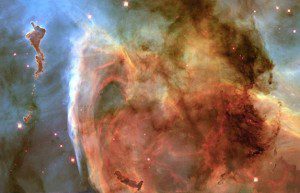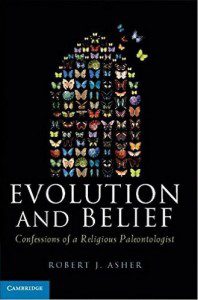 Robert Asher concludes his book Evolution and Belief with a brief discussion of probability in biology and closing thoughts on the belief in God. The randomness and improbability of evolution is often emphasized in the popular literature, but evolution is not a random process. Concepts of probability and randomness in biology are often seriously misunderstood.
Robert Asher concludes his book Evolution and Belief with a brief discussion of probability in biology and closing thoughts on the belief in God. The randomness and improbability of evolution is often emphasized in the popular literature, but evolution is not a random process. Concepts of probability and randomness in biology are often seriously misunderstood.
Probability and Contingency. Asher uses the example of dice. Suppose we role five dice, three times in succession. The odds of getting any particular outcome, whether 1,2,3,4,5 three times in a row or precisely the three outcomes in the figure to the right, is 1 in 470 billion. If I rolled the dice, with four seconds allowed per roll we would expect this outcome on three consecutive roles about once every 61000 years. About three times a day I’d get the right first roll, 1,5,6,1,1 raising my hopes … but the full sequence could come on day one, or day 22 million, or not at all in 61000 years. Of course, the fact that I got the rolls shown in the picture is not surprising, we cannot rationally argue from odds that some designer must have arranged it. When I rolled the dice I had to get some result out of the 470 billion possibilities. (Asher got different numbers on his rolls.)
In another example, consider your church on Sunday. Each of those people developed from one of about 400 maternal eggs and one of a couple hundred billion sperm produced by their parents. The odds that each of those people were born with precisely the given genetic traits and that they would meet in that church on Sunday is infinitesimal. Unimaginably improbable. But we are not particularly surprised when it occurs. Some one of the multitude of possible combinations had to occur. Asher uses the example of his second-year class on vertebrate biology, but the point is the same.
These examples illustrate the difference between contingency and chance in history. Contingency is the retrospective appreciation of how what happens is one possibility out of many, one which is dependent upon what else has happened. Some combination of numbers has to result with every roll of the dice, although each combination, by itself, is improbable. The occurrence of some series of numbers after a roll of the dice is not only probable, but certain. (p. 202)
 The particular result shown for my three rolls of five dice is contingent on a roll of 1, 5, 6, 1, 1 on the first roll. If I had not gotten a one on the first roll of the first die this result would not have been possible. Asher applies these ideas to the “fine-tuning” of the universe.
The particular result shown for my three rolls of five dice is contingent on a roll of 1, 5, 6, 1, 1 on the first roll. If I had not gotten a one on the first roll of the first die this result would not have been possible. Asher applies these ideas to the “fine-tuning” of the universe.
Contingency is why you should not be impressed when someone tells you how incredibly improbable the conditions for life are in this universe thereby implying that someone or something out there planned our existence all along. …
The anthropic principle is unimpressive as an argument for a human-like “god” because had the initial conditions of the universe been different immediately following the Big Bang something else would have existed, perhaps amenable to another form of consciousness. …
Our existence is certainly improbable, but such improbability is by itself not a compelling argument directing us toward the action of a human-like force, priming the cosmic way for our existence. The improbability of our world is contingent on a series of events that could have unfolded in another way, and in so doing would have resulted in some other, equally improbable course of cosmic history. (p. 204)
I’d put this last a little differently. From the final result shown in my images above there is no way of knowing whether I designed the result by placing the dice according to a pattern of my choosing or rolled the dice getting a random result. From the result alone you cannot not convincingly argue either for or against a designer (in this case me).
The improbability of biological organisms is no different than the improbability of the universe as a whole. The result we see around us is what happened, whether probable or improbable, designed or not.
Convergence and Biased Selection. The second important point involves constraints on evolution. There are only so many ways to utilize solar radiation to produce chemical energy, to focus light, to collect the density fluctuations we call sound. “If you want to swim, fly, or dig, three are only so many shapes that allow you to do this in an efficient manner.” (p. 205) Evolutionary processes often converge on similar solutions to these various challenges as organisms adapt to thrive in similar environments.
The phenomenon of convergence reflects an important fact: evolution by natural selection is not random. If it were, and the constraints of development and environment had less impact on how animals evolved, we would expect to see far more differences in form and function of anatomical and genetic features across animals and plants. (p. 205-206)
Physics and chemistry along with engineering principles, constrain evolution and result in convergence. In addition, evolution involves the biased selection of functional adaptations. This doesn’t require a predetermined goal, just a criterion of survival. Genes and organisms don’t adapt to survive, rather only those that survive reproduce. It is important that we not anthropomorphize the gene, providing an imaginary mind, morality, and purpose. Because conditions are moderately stable, the survival conditions in the past facilitate increased complexity in the present.
Complexity. Another common objection to evolution is irreducible complexity. The idea that complex structures had no evolutionary function or advantage before they were fully formed. The bacterial flagellum is the example mad famous by Michael Behe in Darwin’s Black Box. The weakness in this argument is the observations that structures can change function as they evolve. Behe’s proposals have focused the effort of a number of scientists on this aspect of evolution – the “exaptation” of existing structures for new functions. Substructures with separate functions were gradually adapted and modified into a complex structure such as the flagellum. This is not unlike the gradual modification of jaw bones into ear bones discussed earlier (Always in Transition). There are many structures and systems in biology where function and constraints remain poorly understood. Cell biology and biochemistry are incredibly complex. Evolutionary pathways often involve steps that are lost in the mists of time. But to jump from incomplete understanding and tentative explanations to the conclusion “naturally impossible therefore designed” is unwise.
God. Neither probability nor complexity provide smoking gun evidence for the existence of an intelligent designer of the universe. Nor do cosmology, contingency, or evolution provide convincing arguments against the existence of an intelligent designer. Biology and divine action are not competing descriptions. Asher quotes N.T. Wright:
All this business about God intervening is not a language I use, because that implies God is outside the process and occasionally reaches in and stirs the pot and then goes away again. Whereas in Psalms … God is the one who “feeds the ravens when they call on him.” What, does he throw them tidbits from heaven? No, it’s a way of describing the fact that God is active in the world. (p. 227, quote from a 2008 lecture by Wright)
Awareness of natural processes or causes, whether evolution, meteorology, embryology, or the food chain providing nourishment for ravens, do not undercut God as the agent responsible for the diversity of life, the weather, the development of a fetus into a human or the feeding of the ravens.
An understanding of biological cause neither supports nor denies the existence of a deity behind life. Speaking for myself, I accept this deity based on my own intuition, and I make no pretense that this intuition has any scientific basis. However, although I acknowledge my belief to be nonscientific, it is entirely rational. Science is a subset of rationality; the former has a narrower scope than the latter. To ignore rationality when it does fall beyond the scientific enterprise would be an injustice to both reason and humanity.
A Wrap. This concludes out walk through Asher’s book. We have only skimmed the highlights. This is a book focused on evolution. It is not a book that digs into the intersection of science and faith in any detail. Asher is a mammalian paleontologist and he presents a convincing array of evidence for the scientific understanding of evolution. He does not deal with the Cambrian explosion (not his area of expertise) or the origin of life. Evolutionary biology is concerned with the mechanisms for and history of diversification once life existed, not with the origin of life in the first place. Asher focuses on gradual changes such as those that made mammals out of amphibious tetrapods and whales out of land animals over millions of years. Each step was microevolutionary, but the result was macro. This is a fascinating book, and Asher’s expertise and ability as a teacher enable him to make the case.
This is not an academic book, but neither is it a light and easy read of the highlights of evolution. Asher puts effort into building the case for the specific examples he considers. It is designed for the curious readers who wants to gain an appreciation of the strength of the case for evolutionary biology.
Asher also spends a fair bit of ink interacting with and refuting the ideas put forth by a range of opponents of evolution. I skipped over these discussions and focused instead on his positive arguments for evolution. Those who are interested in this discussion, and why most biologists in particular and scientists in general find the arguments for Intelligent Design and Special Creation unconvincing, will find this part of the book interesting as well.
Evolution and religious belief are not in competition.
If you wish to contact me directly you may do so at rjs4mail[at]att.net.
If interested you can subscribe to a full text feed of my posts at Musings on Science and Theology.












